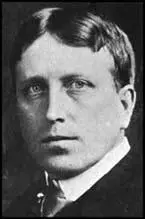William Randolph Hearst

William Randolph Hearst, the son of George Hearst, a newspaper proprietor, was born in San Francisco in 1863. After studying at Harvard University (1882-85) he took over the San Francisco Examiner from his father in 1887.
Inspired by the journalism of Joseph Pulitzer, Hearst turned the newspaper into a combination of reformist investigative reporting and lurid sensationalism. He soon developed a reputation for employing the best journalists available. This included Ambrose Bierce, Stephen Crane, Mark Twain, Richard Harding Davis and Jack London.
In 1895 Hearst purchased the New York Journal. He was now in competition with Pulitzer's New York World. This included recruiting the popular cartoonist, Richard F. Outcault from Joseph Pulitzer. Hearst also reduced the price of the New York Journal to one cent and included colour magazine sections. He also persuaded Frederick Opper, another of Pulitzer's cartoonists, to join his team.
Pulitzer's New York World and Hearst's New York Journal became involved in a circulation war, and their use of promotional schemes and sensational stories became known as yellow journalism. However, he received praise from the radical journalist, Lincoln Steffens: "Hearst, in journalism, was like a reformer in politics; he was an innovator who was crashing into the business, upsetting the settled order of things, and he was not doing it as we would have done it. He was doing it his way. I thought that Hearst was a great man, able, self-dependent, self-educated (though he had been to Harvard) and clear-headed; he had no moral illusions; he saw straight as far as he saw, and he saw pretty far, further than I did then; and, studious of the methods which he adopted after experimentation, he was driving toward his unannounced purpose: to establish some measure of democracy, with patient but ruthless force."
Over the next few years Hearst became the owner of 28 newspapers and magazines, including the Los Angeles Examiner, the Boston American, the Atlanta Georgian, the Chicago Examiner, the Detroit Times, the Seattle Post-Intelligencer, Cosmopolitan and the Washington Herald. He used his newspapers and magazines to campaign for an aggressive foreign policy. As a result of distorted and exaggerated reporting, Hearst was blamed for the war between the United States and Spain (1897-98).
Hearst was a member of the United States House of Representatives (1903-07) However, he was defeated for mayor (1905 and 1909) and the post of governor of New York (1906). An opponent of the British Empire, Hearst opposed United States involvement in the First World War and attacked the formation of the League of Nations.
In the 1920s Hearst built a castle on a 240,000 acre ranch at San Simeon, California. At his peak he owned 28 major newspapers and 18 magazines, along with several radio stations and movie companies. However, the Great Depression weakened his financial position and by 1940 he had lost personal control of his vast communications empire.
Hearst upset the left-wing in America by being a pro-Nazi in the 1930s and a staunch anti-Communist in the 1940s. William Randolph Hearst died in 1951. It is believed that Hearst's career inspired the Orson Welles film, Citizen Kane.
Primary Sources
(1) Lincoln Steffens, Autobiography (1931)
Hearst, in journalism, was like a reformer in politics; he was an innovator who was crashing into the business, upsetting the settled order of things, and he was not doing it as we would have done it (The American Magazine). He was doing it his way. I thought that Hearst was a great man, able, self-dependent, self-educated (though he had been to Harvard) and clear-headed; he had no moral illusions; he saw straight as far as he saw, and he saw pretty far, further than I did then; and, studious of the methods which he adopted after experimentation, he was driving toward his unannounced purpose: to establish some measure of democracy, with patient but ruthless force.
